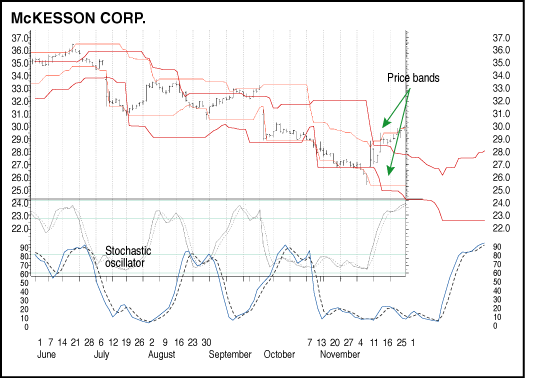Stochastics And Price Range Dynamics
Home, Home On The Range
by Andrew Tomlinson
Price ranges are used in signaling both reversals and breakouts. Looking at how stochastics perform in breakouts sheds light on several key characteristics of the indicator.
One of the trading systems I use is based on changes in momentum. There's nothing particularly high-tech or unique about it, but it means that I've been looking at a lot of breakouts. And one of the interesting things about breakouts is that they often affect indicators in unexpected ways. They act as a kind of stress test, pushing market metrics to extremes, and as a result, they make me look a little closer. In my last Stocks & Commodities article, I looked at how volume indicators behaved under stress. On this occasion, it's the behavior of the stochastics indicator that caught my eye, particularly when compared to a Donchian price channel.
WHAT I FOUND
Figure 1 shows the price action of McKesson Corp. (MCK) in the autumn of 2004. The upper window shows the price bars along with 14-day price bands of the highest high and lowest low. The chart shows a series of downward price breakouts, most notably on July 1 and September 8. The lower window shows a 14-bar stochastic.

FIGURE 1: BEFORE YOU DECIDE ON YOUR FLAVOR. A series of breakouts in MCK in the autumn of 2004 make a variety of impacts on the 14-day stochastic.
The first thing I noticed is that there are no breakouts in the stochastic - that is, nothing that showed a breakout had taken place. Yes, there was a move to the lower part of the indicator range, but nothing that distinguished a steady move down to the bottom of a narrow channel (for example, June 17-28, a 7%, seven-day decline), from an abrupt breakout (September 8, a 16%, one-day drop). The size of the stochastic move was particularly small if the drop was from the bottom of the prior range rather than the top. So the July 1st, 12.6% drop looks like a little blip on the stochastic because the drop was from the bottom of the prior range - that is, the stochastic was already oversold, unlike the September 9th drop, which appears much bigger on the stochastic because the fall was from the top of the prior range.
This insensitivity when the stochastic is in overbought or oversold
territory is illustrated again by the steady 21% decline through September
and October, which shows on the stochastic as a wobbly line in oversold
territory. The other observation related to the breakouts is the length
of time the stochastic takes to react, so the 16% drop on September 8 registers
on the stochastic only as a drop to 38.8; it doesn't reach bottom until
September 10.
...Continued in the August issue of Technical Analysis of STOCKS & COMMODITIES
Excerpted from an article originally published in the August 2005 issue of Technical Analysis of STOCKS & COMMODITIES magazine. All rights reserved. © Copyright 2005, Technical Analysis, Inc.
Return to August 2005 Contents